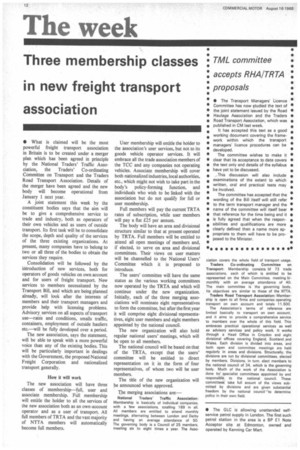Three membership classes in new freight transport association
Page 14

If you've noticed an error in this article please click here to report it so we can fix it.
• What is claimed will be the most powerful freight transport association in Britain is to be created under a merger plan which has been agreed in principle by the National Traders' Traffic Association, the Traders' Co-ordinating Committee on Transport and the Traders Road Transport Association. Details of the merger have been agreed and the new body will become operational from January I next year.
A joint statement this week by the constituent bodies says that the aim will be to give a comprehensive service to trade and industry, both as operators of their own vehicles and as users of outside transport. Its first task will be to consolidate the scope. depth and quality of the services of the three existing organizations. At present, many companies have to belong to two or all three of the bodies to obtain the services they require.
Consolidation will be followed by the introduction of new services, both for operators of goods vehicles on own account and for users of freight transport. New services to members necessitated by the Transport Bill, and which are being planned already, will look after the interests of members and their transport managers and provide help with licensing problems. Advisory. services on all aspects of transport use—rates and conditions, smalls traffic, containers, employment of outside hauliers etc—will be fully developed over a period.
The new association, says the statement, will be able to speak with a more powerful voice than any of the existing bodies. This will be particularly important in dealings with the Government, the proposed National Freight Corporation and nationalized transport generally.
How it will work
The new association will have three classes of membership—full. user and associate membership. Full membership will entitle the holder to all the services of the new association both as an own-account operator and as a user of transport. All full members of TRTA and the vast majority of NTTA members will automatically become full members.
User membership will entitle the holder to the association's user services, but not to its goods vehicle operator services. It will embrace all the trade association members of the TCC and any companies not operating vehicles. Associate membership will cover both nationalized industries, local authorities, etc., which might not wish to take part in the body's policy-forming function, and individuals who wish to be linked with the association but do not qualify for full or user membership.
Full members will pay the current TRTA rates of subscription, while user members will pay a flat E25 per annum.
The body will have an area and divisional structure similar to that at present operated by TRTA. Full members will be entitled to attend all open meetings of members and, if elected, to serve on area and divisional committees. Their views on user matters will be channelled to the National Users' Committee which it is proposed to introduce.
The users' committee will have the same status as the various working committees now operated by the TRTA and which will continue under the new organization. Initially, each of the three merging associations will nominate eight representatives to form the committee, but after the first year it will comprise eight divisional representatives, eight user members and eight members appointed by the national council.
The new organization will also hold regular national users' meetings, which will be open to all members.
The national council will be based on that of the TRTA, except that the users' committee will be entitled to direct representation on it in the form of four representatives, of whom two will be user members.
The title of the new organization will be announced when approved.
The merging associations are:— National Traders Traffic Association: Membership is basically of individual companies. with a few associations, totalling 189 in all. All members are entitled to attend monthly meetings, alternating between London and Derby and having an average attendance of 50. The governing body is a Council of 25 members, meeting six to eight times a year. The Asso • 0 • • • • • • • • s • • • • • 55 ciation covers the whole field of transport usage.
Traders Co-ordinating Committee on Transport: Membership consists Of 73 trade associations, each of which is entitled to be represented on the Main Committee, meeting bimonthly with an average attendance of 40. The main committee is the governing body. Its objectives are similar to those of the NTTA.
Traders Road Transport Association: Membership is open to all firms and companies operating transport on own account and totals 11.500.
The Association's terms of reference are limited basically to transport on own account, and it aims to provide a comprehensive service to members over the whole of this field. This embraces practical operational services as well as advisory services and policy work. It works through a Head Office in Croydon and eight divisional offices covering England, Scotland and Wales. Each division is divided into areas, and both open and committee meetings are held regularly in areas and divisions. Structurally, the divisions are run by divisional committees, elected by members. Divisions, in turn, elect members to the national council of 34. which is the governing body. Much of the work of the Association is done by specialist committees appointed by and responsible to the national council. These committees take full acount of the views submitted by divisions and are given substantial freedom by the national council to determine policy in their own field.




































































































